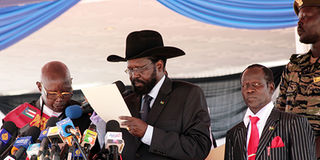The man at the helm of Africa’s youngest State

Salva Kiir (centre) is sworn-in as the President of Southern Sudan during at the Dr. John Garang Mausoleum in Juba on May 21st, 2010. PHOTO/STEPHEN MUDIARI
When he was suddenly installed as the leader of South Sudan in 2005 following the death of Dr. John Garang, few people outside Sudan knew Salvar Kiir Mayardit.
There was much anxiety in the region then that the unexpected death of the legendary and charismatic Dr. Garang was likely to push Sudan back to war, or that Khartoum would renege on the Comprehensive Peace Agreement (CPA).
However, Kiir was involved in the early stages of the negotiations that led to the 2005 peace deal and was already known to the Government in Khartoum before he became National Vice-President.
Kiir, despite lacking the charisma and the visibility of the late Garang has made good account of himself. He not only ably picked from where Garang left the peace process by forging relations with the North, but kept his cool despite the provocations from Khartoum in the last six years of the interim period. He is now the first President of Africa’s newest State - South Sudan.
Kiir, who is a founder member of the Sudanese People’s Liberation Army (SPLA), has long supported full independence for the South.
He has often repeated Gerang’s famous quote, which he did again in the run-up to the Referendum.
“The upcoming referendum is a choice between being a second-class citizen in your own country, or a free person in your independent state.”
His quest for a separate South made him not take on President Omar al-Bashir during the 2010 general elections. Some had expected him to test his popularity at the national level but Kiir chose to concentrate on the secession of the South instead.
Analysts say that if he challenged al Bashir and lost, that could have damaged his political standing in the South.
Kiir was elected as the President of South Sudan with 93 percent of the vote in the 2010 elections.
On becoming the President of South Sudan in 2005, his main task was to ensure that the Referendum took place as prescribed in the CPA.
He was also faced with a number of challenges among them, the militia groups in the South that are yet to surrender their arms, corruption within some ministries, balancing the many ethnic groups within the government, and the challenge to fit in Dr. Garang’s shoes.
Like the late Garang, Kiir comes from the Dinka which is the largest ethnic group in the South. But unlike Dr. Garang, the former military commander though not an intellectual is popular among the SPLM’s military wing. Indeed, the SPLA cadres attribute successes in the field during the bush war to Kiir.
He has risen from humble beginnings to the top. He first joined the Southern rebellion in 1960s, become a founder member of SPLA/SPLM in 1983, become a military leader in the 1990s and in 2005 became Southern leader and National Vice-President.
With the birth of the new nation, the biggest challenge for Kiir will be cooling the tension that is likely to emerge among the ethnic groups in the new republic.
The Nuer, the second most numerous in the South, resent the perceived Dinka dominance. During the 21 year war, the two took to arms against at each other while at other times they joined forces against the North.
Currently, Kiir is seen as one of the few people who are capable of keeping the South united. He has also gained international respect by refusing to be provoked by Khartoum into war over Abyei and Southern Kordofan.




